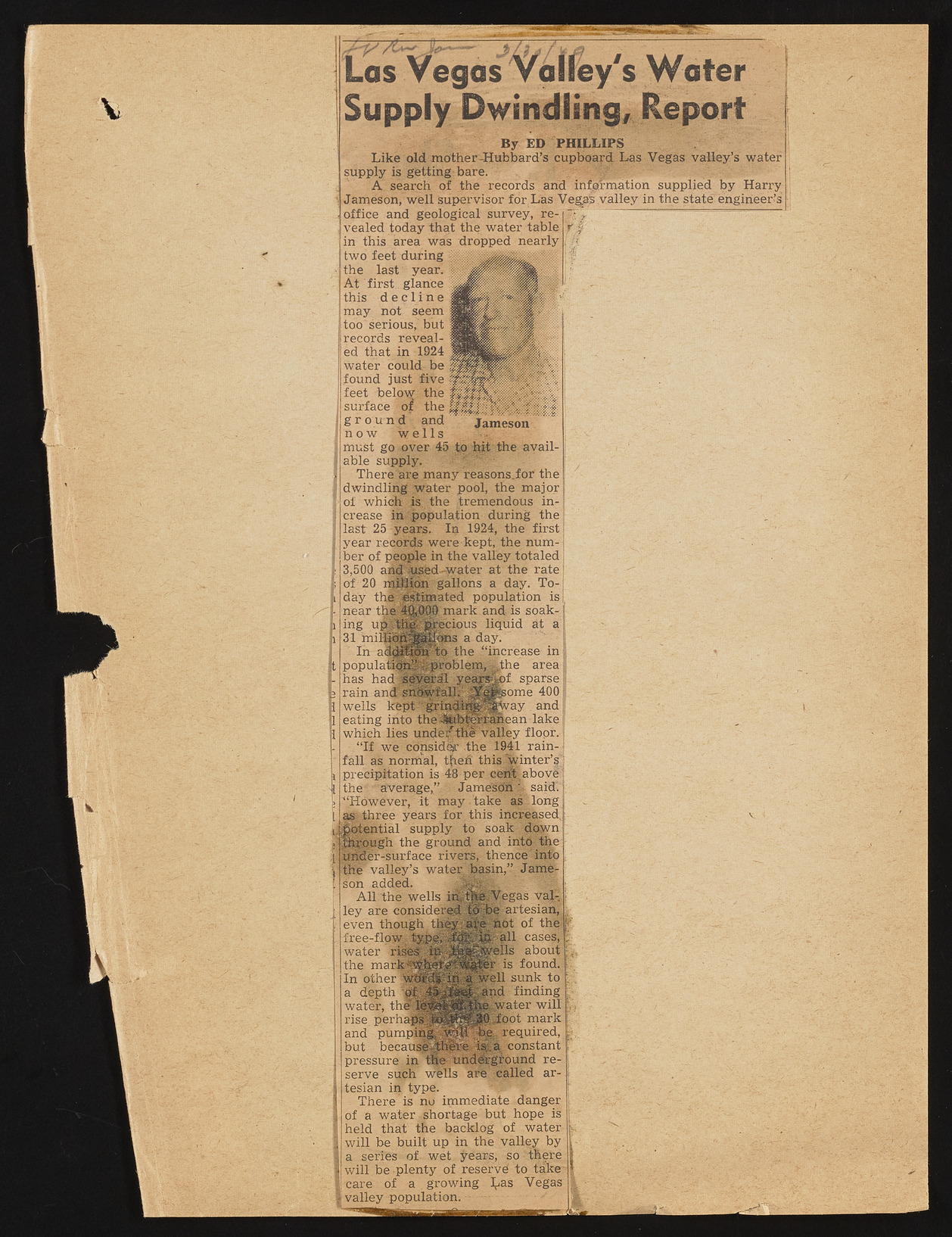Copyright & Fair-use Agreement
UNLV Special Collections provides copies of materials to facilitate private study, scholarship, or research. Material not in the public domain may be used according to fair use of copyrighted materials as defined by copyright law. Please cite us.
Please note that UNLV may not own the copyright to these materials and cannot provide permission to publish or distribute materials when UNLV is not the copyright holder. The user is solely responsible for determining the copyright status of materials and obtaining permission to use material from the copyright holder and for determining whether any permissions relating to any other rights are necessary for the intended use, and for obtaining all required permissions beyond that allowed by fair use.
Read more about our reproduction and use policy.
I agree.Information
Digital ID
Permalink
Details
Member of
More Info
Rights
Digital Provenance
Publisher
Transcription
LasVegasVolfey's Water Supply Dwindling, Report By ED PHILLIPS Like old mother-Hubbard’s cupboard Las Vegas valley’s water supply is getting bare. A search of the records and information supplied by Harry Jameson, well supervisor for Las Vegas valley in the state' engineer’s office and geological survey, re +hp vealed today that the water table in this area was dropped nearly two feet during the last year. At first glance this d e c l i n e may not seem ?too'serious, but records revealed that in 1924 water could be found just five .... feet below the surface of g r o u n d and Jameson n o w w e l l s must go.over 45 to hit the avail- I able supply. There are many reasons.fpr the dwindling water pool, the major ] of which is the tremendous increase in population during the last 25 years. In 1924, the' first! year records were kept, the num- j her of people in the valley totaled j 3,500 and used-water at the rate; of 20 million gallons a day. To-j day the estimated population is. near thev'f^Qg. mark and is soak-J ing u^stlfep^cipus liquid at a | 31 m i a day. | Y In- aaj^^m^p'the “increase- ini populatibnhhp^’oblem, j Lthe area [ has hacHse'yeral yeaysjbf. sparse! rain and^shbwfall.' ^J^pome 400 i wells and eating into the Jjiibf&ranean lakef which lies under tKe valley flopr. “ If we consider the 1941 rainfall as normal, thed this winter’|' precipitation is 48 per cent abovli the’1 "average,”.;-- JameSdh 1 said'.; “However, it may take as long 1 as three years for this increased. .-Potential supply to soak down through the ground and into the undersurface rivers, thence into tlie- valley’s water basin,” Jameson added. All the wells ir&fte.Vegas valley are considered K b p artesian, even though theyfafe hot of the free-flpw j,typ^?^^iall ®se|| water about the mark !“ hej .?: v.i.iCj if found. In other WdSffapji a well sunk to a depth? of,;-4l>j^ » . , aPd finding water, th l will rise perh£^^p8H B|ti<#t mark and pum pih ^ ^ p^ > ^ . required, but becaiise^Htme - is;-,a constant pressure, in the underground reserve such wells are called artesian in type. There is no immediate danger of a water shortage but hope is held that the backlog of water will be built up in the valley by a series of- wet years, so there J will be plenty of reserve to take care of a . growing Has Vegas { valley population. .....

